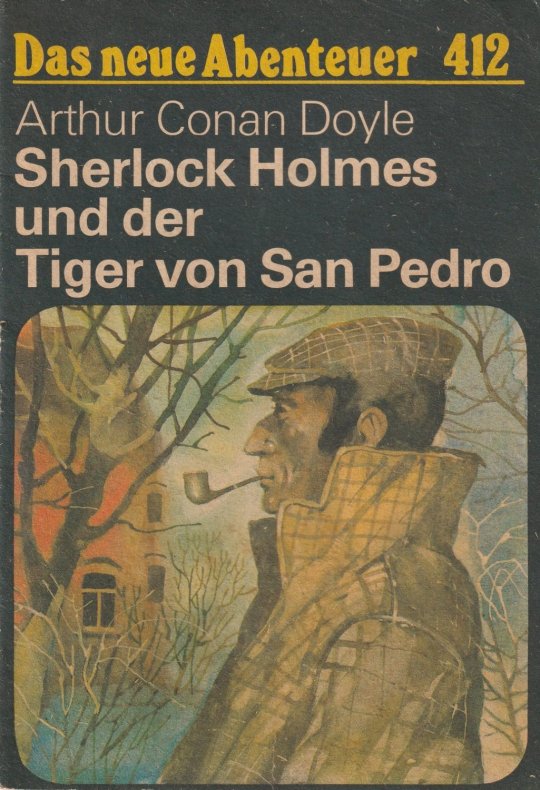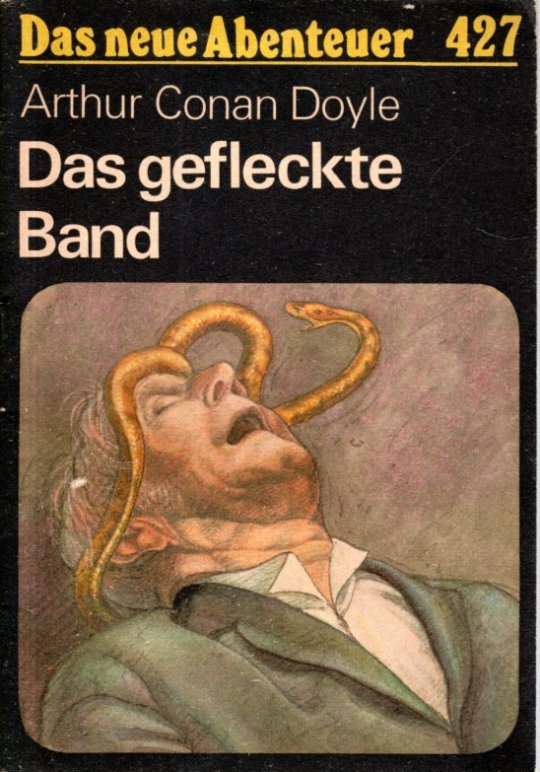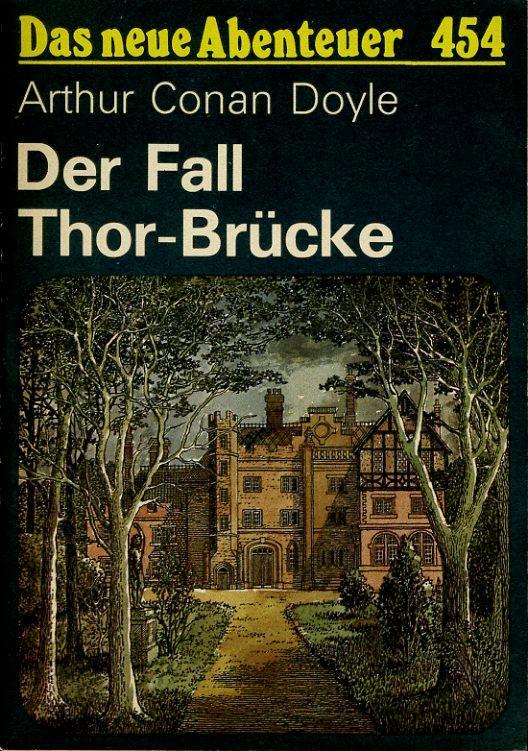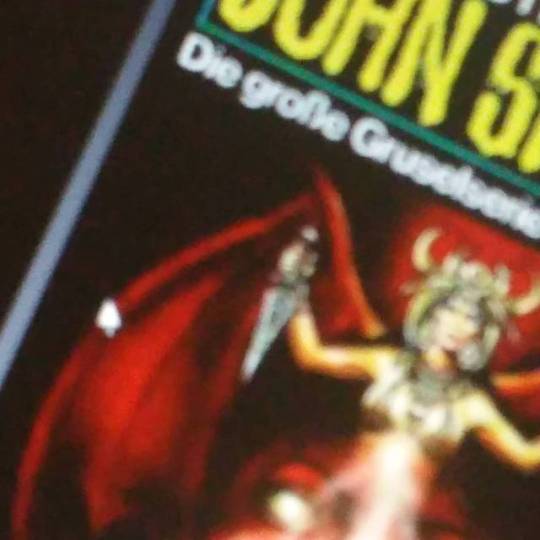#Heftromane
Explore tagged Tumblr posts
Text




"Sherlock Holmes und der Tiger von San Pedro" (The Adventure of Wisteria Lodge), "Das gefleckte Band" (The Adventure of the Speckled Band), "Der Fall Thor-Brücke" (The Problem of Thor Bridge), und "Silver Blaze" (The Adventure of Silver Blaze) von Arthur Conan Doyle (Neues Leben 1981-84)
#most of the german titles are about the same but occasionally they just. change entirely#sherlock holmes#book cover#german#wist#spec#THOR#SILV#das gefleckte band#der tiger von san pedro#der fall thor-brücke#silver blaze#holmes#die abenteuer des Sherlock Holmes#die abenteuer von sherlock holmes#das neue abenteuer#heftroman#vintage book#vintage book cover#vintage buch#acd#sir arthur conan doyle#arthur conan doyle
2 notes
·
View notes
Text
Der heutige Plan, ich will an dem Heftroman weiterschreiben, vielleicht mal ohne große Unterbrechungen. Dann möchte ich mindestens ein Buch zu Ende lesen, bin weit hinter meinem Plan, bisher erst 43 von 150 im Jahr 2023.
0 notes
Text

Ich wollte heute mal etwas anderes posten, weil die Antwort zur #autorinnenchallenge ein langweiliges "nein" gewesen wäre. Deswegen versuche ich, einen neuen Hashtag für die #leseratte in euch zu platzieren: #obskurebücher bzw. #kuriosebücher
Ich habe ja ein Faible für alte Bücher. Also, ALTE Bücher. Die Dinge, die man am ehesten bei einer Entrümpelung findet. Daher habe ich auch eine Reihe Kuriositäten aus den vergangenen +/- 150 Jahren. Den Anfang macht diese "Heftroman-Reihe" (?). Ehrlich, ich weiß nicht einmal, wie ich diesen eindeutig spirituellen Roman aus 1940 bezeichnen soll. Die einzelnen Hefte sind in sich abgeschlossene Teile, die die spirituelle Geschichte eines Steines (ja, Stein. Wie Fels) und einer Königin beschreiben. Es handelt sich um eine Liebesgeschichte, die sich vom alten Ägypten bis zum Wilden Westen erstreckt. Der Stein reinkarniert dabei in immer höhere Sphären, bis er schließlich als Mensch seine ewige Geliebte ehelicht. Zumindest ist das meine Erinnerung.

Der Verlag war seinerzeit ein bedeutender Vertreter für esoterische und okkulte Literatur im deutschsprachigen Raum, wurde aber von den Nazis zerschlagen. Das seltsame Nachwort dürfte also ein Versuch gewesen sein, sich vor dem Regime zu verstecken. Eine spätere Neugründung ging 2002 in Insolvenz (Quelle: Wikipedia. Der Verlag ist so obskur, dass verlässliche Quellen schwer zu finden sind).
Was für #kuriositäten finden sich in eurem #bücherregal ?
#bookstagram#lesen#leseliebe#schreibliebe#altebücher#buchtipp#leseraufinstagram#autorenaufinstagram#geschichte#historisch#history#deutschland#deutsch
1 note
·
View note
Photo



John Sinclair #096 - Asmodina’s Lair #103 - Asmodina’s Death Angels #202 - Bring me the Head of Asmodina
46 notes
·
View notes
Text

Aether Gazette Nummer 29/07/1879/+142
#aethergazette#gazette#groschenheft#newspaper#phantastik#steampunk#zeitung#geschichten#heftroman#amtfueraetherangelegenheiten#funtasy#aetherleaks
1 note
·
View note
Photo

John Sinclair #1081. Erstauflage #collection #collector #collectors #sammlung #sammeln #sammelleidenschaft #sammelfieber #sammler #buecher #bücher #buch #heftroman #johnsinclair https://www.instagram.com/p/B86Ww1CI0D8/?igshid=1nlfu0mgf8p80
#1081#collection#collector#collectors#sammlung#sammeln#sammelleidenschaft#sammelfieber#sammler#buecher#bücher#buch#heftroman#johnsinclair
1 note
·
View note
Text
2017 und 1935
Kopfdurchweichung durch das Radio, eine vergessene Gefahr
Ich lese zum zweiten oder dritten Mal den Krimi “Wachtmeister Studer” von Friedrich Glauser. Bei der letzten Lektüre in den 1990er Jahren hatte die Ausgabe den viel schöneren Titel “Schlumpf Erwin Mord”. Ich erinnere mich nicht an meine Meinung von früher, bin diesmal aber nicht begeistert, die Personenbeschreibungen sind mir zu verächtlich, die Klischees zu zahlreich. Was ich vor zwanzig Jahren auch überlesen habe, ist die Rolle, die das Radio in der Geschichte spielt. Der Roman ist 1935 entstanden, das Radio war erst wenige Jahre alt und störte brave und konservative Bürger wie den Wachtmeister Studer offenbar sehr.
Zuerst ist es nur ein wenig laut im Dorf Gerzenstein, in dem sich der Mord zugetragen hat:
“Aus der Tür des Coiffeurladens quoll eine knödlige Stimme: ‘Sie hören jetzt das Zeitzeichen des chronometrischen Observatoriums in Neuchâtel ...’ Und gedämpft, durch die geschlossene Türe drang aus dem Laden, vor dem Studer stand, der ‘Sambre et Meuse’-Marsch ... ‘Das Dorf Gerzenstein liebt Musik ...’, stellte der Wachtmeister bei sich fest und betrat den Coiffeurladen.”
Das Zeitzeichen des Observatoriums in Neuchâtel wird zum Zeitpunkt der Romanentstehung seit vier Jahren von Radio Beromünster übertragen, hier kann man es hören. Radio Beromünster wurde 2008 abgeschaltet, das Zeitzeichen 2012 zum letzten Mal gesendet.
Die gleiche Erkenntnis über die Lärmfreudigkeit von Gerzenstein hat der Wachtmeister ein paar Seiten später noch einmal:
“Und als er die Dorfstraße entlangging, vorbei an den vielen Schildern, die sich folgten, fiel ihm eine zweite Eigentümlichkeit dieses Gerzensteins auf. Aus jedem Hause drang Musik; manchmal unangenehm laut aus einem geöffneten Fenster, manchmal dumpfer, wenn die Fenster geschlossen waren. ‘Gerzenstein, das Dorf der Läden und Lautsprecher’, murmelte Studer, und es war ihm, als sei mit diesen Worten ein Teil der Atmosphäre des Dorfes charakterisiert ...”
Bei den wenigen anständigen Menschen in Gerzenstein herrscht nicht so ein Krach:
“Es sei so still hier, sagte Studer nach einer Weile, worauf Murmann lachte. Er habe eben keinen Lautsprecher wie die anderen Gerzensteiner, sagte er. Da lachte auch Studer.”
Aber sonst überall:
“So stand Studer wieder auf der asphaltierten Straße. Rechts und links, so weit der Blick reichte: Läden, Läden, Läden. Und die Häuser waren nicht stumm ... Es war Samstagnachmittag. Durch die Mauern, durch die geschlossenen Fenster und durch die geöffneten jodelte das Gritli Wenger – Es jodelte den Sonntag ein ...”
Nicht nur der Lärm ist ein Problem. Die Menschen haben gar keine eigenen Stimmen mehr, sie sind vom Radio vergiftet worden:
“Es war gespenstisch. Die Wirtin redete und Studer hatte den Eindruck, das Gritli Wenger jodeln zu hören. Und als der Wirt auch noch dazu kam (viel jünger schien er als seine Frau, er hatte O-Beine und war, wie sich später herausstellte, Dragonerwachtmeister), ja, als der Wirt zu sprechen begann, hatte er wahr- und wahrhaftig die Stimme des Konditorkomikers Hegetschweiler. Wo hatten die Leute ihre Stimmen gelassen? Waren sie vom Radio vergiftet worden? Hatten die Gerzensteiner Lautsprecher eine neue Epidemie verursacht? Stimmenwechsel? Da, da war es wieder ... Draußen beklagte sich einer, er habe nichts mehr zu trinken, und er sprach diese einfachen Worte in so singendem Tonfall, daß Studer meinte, den Schlager zu hören: ‘Ich hab’ kein Auto, ich hab kein Rittergut ...’”
Nicht einmal der Sonntag ist heilig, überall krächzt und summt es auf unheilige Art:
“Man spürte den Sonntag. Verlassen sahen die Häuser aus, aber sie waren nicht stumm, nicht einmal heute. Ein Krächzen hier, ein Summen dort, manchmal ein Melodiefetzen ... Die Lautsprecher Gerzensteins spielten mit den atmosphärischen Störungen, es war niemand da, der sie beaufsichtigte ... So trieben sie Schabernack, für sich allein, um die Langeweile des einsamen Nachmittags zu würzen ... In der Woche gab es so viel zu tun für sie. Sie sangen, sie spielten, sie sprachen. Professoren, Bundesräte, Pfarrer, Psychologen – gehorsam blökten die Lautsprecher die Worte nach, die irgendein bedeutender Herr von seinem Manuskripte ablas – und die Worte drangen in die Ohren der Gerzensteiner, durchweichten die Köpfe ... Sie wirkten wie ein Landregen auf Moorland ... Die Lautsprecher waren die Beherrscher Gerzensteins. Redete nicht selbst der Gemeindepräsident Aeschbacher mit der Stimme eines Ansagers?”
Studer bedient sich allerdings auch schon selbst des Radios bei seinen Nachforschungen. So ganz klar ist dessen Funktion in der Aufklärung des Falls allerdings nicht, es wirkt wie ein noch etwas ratloser Versuch, die neue Technik irgendwo in der Handlung unterzubringen. Telefoniert wird hingegen oft. Dass die Aufzeichnung von Geständnissen nicht möglich oder nicht praktikabel ist, bedauert der Wachtmeister mehrfach:
“Jetzt eine Platte da haben! dachte Studer, und das Gespräch aufnehmen!”
Nicht nur das Radio ist ein Problem, sondern auch der Heftroman, der von allen leicht beeinflussbaren Meitschis und Ladenschwengeln des Buchs gelesen wird und in ihren Köpfen Unheil anrichtet:
“Sonja wußte von nichts, man hatte ihr nichts erzählt, bis man sie vor eine vollendete Tatsache hatte stellen können ... Und auch dann hätte sie sich vielleicht geweigert, wenn ... wenn nicht die Romane gewesen wären: ‘Unschuldig schuldig’ hieß einer ...”
Sogar Studers Frau hat früher einmal selbst solche Heftromane gelesen, “nächtelang – dann war am Morgen der Kaffee dünn und lau gewesen und die Frau schmachtend.” Aber er hat es ihr abgewöhnt, und seitdem “gelang es dem Hedy (Frau Studer hieß Hedwig) gut, geplagte, schweigsame Menschen zum Reden zu bringen – besonders Frauen.”
Das Heftromanlesen kann man den Menschen also wieder abgewöhnen. Vielleicht geht das ja auch mit dem Radiohören, wenn nur der Richtige kommt, ein vernünftiger Mensch wie der Wachtmeister Studer. Wir wollen es hoffen für die Menschen in Gerzenstein, dem Dorf der Läden und Lautsprecher.
(Kathrin Passig)
3 notes
·
View notes
Photo

#lektüre für eine #bahnfahrt gefällig? Jetzt #anotherworld als #ebook exklusiv für #kindle. Ein #SciFi #Abenteuer jetzt als #Heftroman :) #schamloseeigenpromo wer hat es schon gelesen? (hier: Germany) https://www.instagram.com/p/Bz0KV2tAnK8/?igshid=13jyxghrbzzy3
0 notes
Photo

#roman #heftroman #bastei #lübbe #jasondark #geisterjäger #johnsinclair #heuteengelmorgenhexe #band465 (hier: Solothurn, Switzerland)
6 notes
·
View notes
Note
You talked about the difference between pulp heroes and super-heroes, but is there something that differentiates them from 19th century literature heroes like Sherlock Holmes, Nemo or the Count of Monte-Cristo ? Beside the time period, I mean.

The time period and location do play a subtantial part in it, as it’s the closest thing we have to a true, concrete separation between these characters is the contexts surrounding them. Unlike with superheroes, there is no medium separation between them, but also unlike the superheroes, there are much bigger separations between them in regards to time periods and locations. The simplest way to look at it is this: The Victorian Heroes (let’s call them that for now) are the characters of 1800s European literary fiction, while The Pulp Heroes are the characters of 1900s-1950s American literary fiction. To an extent this also applies to the respective time periods the characters occupy. Obviously this is not a comprehensive look at it and there are a lot of exceptions, but we have to start somewhere before we start grappling with the confusion instead of the question.
As I’ve mentioned before, “pulp” is something that doesn’t limit itself to 30s America and never has, not just because the American pulp tradition dates back from even before the start of the 20th century, specifically the 1896 issue of Argosy that introduced the less expensive wood pulp paper and that’s without getting into dime novels which were essentially the same thing, but also because all over the world we can find instances of similar phenomenons occuring. The Germans had the heftromane, the English had penny dreadfuls, the French had the feuilletons, the Chinese had wuxia, Brazil has cordel, the Japanese currently have light-novels, and so on, all of which have very substantial differences regarding their origins and the content of their stories and so on, all of which get more and more complicated the more we stray away from the rigid and inaccurate definition of pulp hero as “30s proto-superhero”.
Trying to define these under a rigid idea of “is” and “isn’t” is an exercise in futility, so what we can do instead is to identify the common and reocurring traits and elements between them, and work our way backwards to find the differences.

I’m going to take three feuilleton characters as an example: Rocambole (created in 1857), Fantomas (created in 1911), and The Phantom of the Opera (created in 1909). All three were published in the same format, in serialized form, all three are either supervillains or proto-supervillains, all three are masked or disfigured arch-criminals with anti-hero aspects who terrorize France along with supporting characters that either assist or oppose them, and yet they clearly don’t belong in the same worlds. Fantomas is a pulp character, The Phantom is considered a Victorian/Gothic icon, and Rocambole tends to be considered somewhere in-between, included in compilings of both Victorian era characters as well as pulp heroes, and he has much more in common with the latter.
Part of their separation also lies in the fact that The Phantom is not the protagonist, unlike the other two, and villain protagonists and supervillains are a reocurring element that pulp fiction established (although, to be clear, not created by it). Additionally, The Phantom was part of a single story rather than a long-running series, and in the hero-monster and protagonist-antagonist dynamic he falls very much on the latter of each, where as Fantomas is a monstrous protagonist and Rocambole underwent a redemption into an anti-hero. The Phantom serves the needs of one story as it’s villain, where as Rocambole and Fantomas are the characters that center several stories. Two of the examples you mentioned, Captain Nemo and The Count of Monte-Cristo, are characters who exist as parts of complete narratives where they play roles, rather than being entities that star at the center of several stories that serve them. By and large, most of those we call Pulp Heroes are characters who star in their own series and have adventures they engage in, where as the Victorian Heroes are often players in stories much bigger than themselves. Again, this is nowhere close to being a “rule” or something set in stone, but it’s a general idea of where the two differ. Story over Character.

Perhaps the best way to find substantial differences is to look at two of their biggest and most influential icons, who existed in the same time period: Sherlock Holmes, and Nick Carter. Holmes was inspired by real life physician and lecturer Dr Joseph Bell. Nick Carter was inspired by turn-of-the-century strongman and celebrity Eugen Sandow. Holmes solved crimes with thoughtful deduction and cunning logic, Carter solved crimes with explosive action and superhuman capabilities. Holmes was largely static and extremely identifiable by his attitude and mood, Carter could disguise his face and voice in a thousand ways and underwent a revamp every decade to match audience tastes. Holmes had few allies besides Watson, Carter had a full supporting cast and even opened up a detective school.
Holmes fought with blackmailers, fraudsters and serial abusers, Carter tangled with lost races, sky pirates and murderous hypnotists. Holmes fought enemies with names like Charles Augustus Milverton, Colonel Moran and Jack Stapleton. Carter fought villains with names like Bird of Paradise, Diana the Arch Demon, Scylla the Sea Robber and Praxatel of the Iron Arm, the first cyborg in fiction. Holmes’s arch-enemy was a crooked, lizard-like professor secretly operating as a criminal mastermind who was an intellectual equal to Holmes, Carter’s was a handsome vivisectionist who was superior than Carter in strength and intellect, made furniture out of humans, taught orphans how to murder and formed the first ever Supervillain Team-Up in fiction.
This isn’t me putting one over the other (I vastly prefer Holmes as a character but Carter’s stories are more appealing to me), but you can start to see some other differences emerge here. Victorian detectives largely solved problems through varied forms of deductive reasoning and assembling of clues, where as the pulp detectives, while not lacking in cunning, take a more swashbuckling violence approach to it. The pulp hero arrived as a action-packed and intrusive figure, too weird and uncanny and a product of it’s cultural moment to be mistaken for it’s predecessors, or sucessors.
In fact, to bring up Lavender Jack again, you can see this contrast play out in real time by the story’s two main heroes, Lavender Jack and Madame Theresa Ferrier

Ferrier is calm, collected reasoning and problem-solving, Jack is calculated bursts of action backed by training, technology and theatrics. Ferrier is strong and sturdy, Jack is fast and tricky. Ferrier is imposing, dignified and dressed in grey overcoats, Jack is a dashing purple devil in a fancy suit and mask. Ferrier is a world-famous figure of respect and intelligence, Jack is an outlaw and urban myth who elicits fascination and disdain alike from the people he strives to protect.
Ferrier takes down attackers by predicting their attacks and applying careful and precise blow, Jack gets into big, messy brawls and cane fights and revels in them. Ferrier uses guns only as empty fake-outs or as last resort, Jack has engineered a device to turn guns against those who yield them manifesting as a showman’s finger snap.
They are products of different generations and different circumstances, they have their own strengths and weaknesses, but there’s a very strong respect between the two and both are ultimately able to shine. I think it illustrates very well some of the ways in which pulp heroes and their predecessors (not necessarily Victorian, although we can use Victorian Heroes as a catch-all term the way we use Pulp Heroes, even though both are not exactly accurate) differ but can also function together if the need arises.

12 notes
·
View notes
Text
Perry Rhodan "TERMINUS" - Guter Beginn einer zwölfteiligen Spin-Off Miniserie. Ein Quick'n Dirty Review
Perry Rhodan “TERMINUS” – Guter Beginn einer zwölfteiligen Spin-Off Miniserie. Ein Quick’n Dirty Review
Perry Rhodan: TERMINUS
Miniserie in 12 Episoden
Erste Folge: Zeitspringer
von Uwe Anton
63 Seiten, Pabel-Moewig Verlag 2017
(Erscheint als Heftserie oder im e-Book Format)
Score: 3,5/5,0
OK – als Jugendlicher und während des Studiums habe ich Perry Rhodan („PR“) gelesen. On-and-Off, sozusagen.
Das ist nun aber mehr als 20 Jahre her.
Wie es der Zufall will, stolperte ich neulich in einem…
View On WordPress
#Heftromane#Pabel-Moewig Verlag#Perry Rhodan#Perry Rhodan Terminus#Review#science fiction#Uwe Anton#Zeitreise
0 notes
Photo




Dead astronauts on the covers of the German science-fiction magazine Terra Extra published in the 1960s. The artwork for Finale is by Johnny Bruck and I believe the others are as well.
Finale - Clark Darlton (pen name of Walter Ernsting) Planet Lerks III - Clark Darlton Der Ring um die Sonne (A Step Farther Out) - Raymond Z. Gallun Zurück aus der Ewigkeit (Back from Eternity) - Clark Darlton
#terra extra#pulp#magazine#german#science fiction#heftromane#dead astronauts#skulls#clark darlton#raymond z. gallun#70 pfennig#moewig#johnny bruck
38 notes
·
View notes
Text

Aether Gazette Nummer 24/07/1879/+142 (Gespensterausgabe)
#aethergazette#gazette#groschenheft#newspaper#phantastik#steampunk#zeitung#geschichten#heftroman#amtfueraetherangelegenheiten#funtasy#aetherleaks
1 note
·
View note
Photo

John Sinclair #838. Erstauflage #collection #collector #collectors #sammlung #sammeln #sammelleidenschaft #sammelfieber #sammler #buecher #bücher #buch #heftroman #johnsinclair https://www.instagram.com/p/B86WtpdIFNF/?igshid=lmy8c7ex48ra
#838#collection#collector#collectors#sammlung#sammeln#sammelleidenschaft#sammelfieber#sammler#buecher#bücher#buch#heftroman#johnsinclair
0 notes

